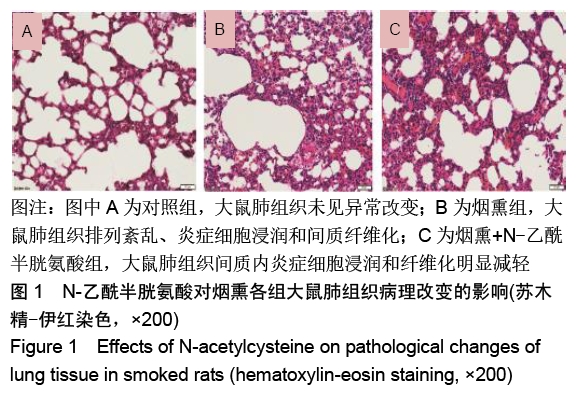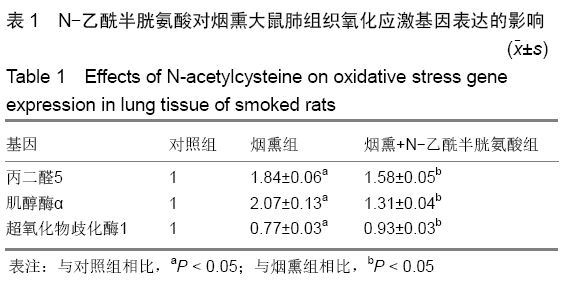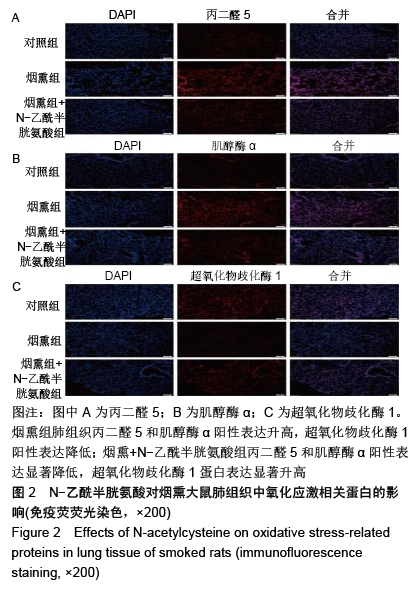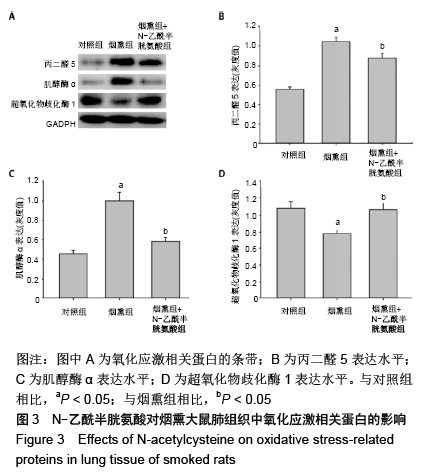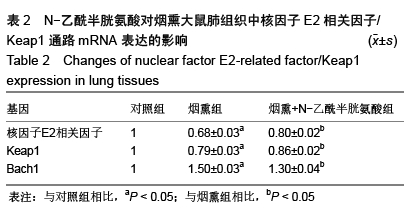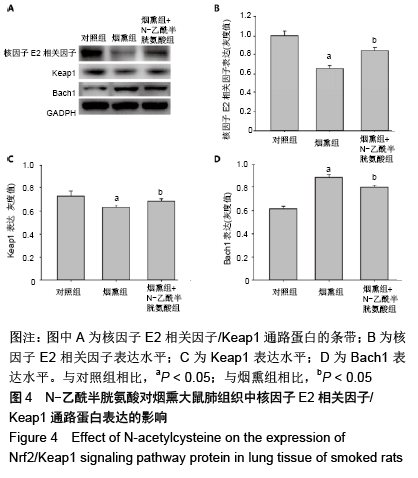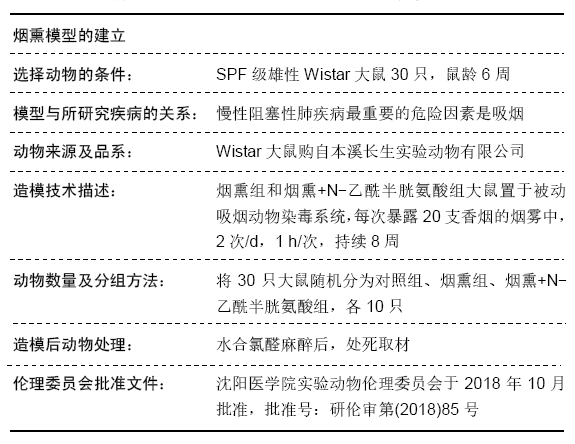[1] CHO J, LEE CH, HWANG SS, et al. Risk of acute exacerbations in chronic obstructive pulmonary disease associated with biomass smoke compared with tobacco smoke. BMC Pulm Med. 2019; 19(1):68.
[2] MORSCH ALBC, WISNIEWSKI E, LUCIANO TF, et al. Cigarette smoke exposure induces ROS-mediated autophagy by regulating sestrin, AMPK, and mTOR level in mice. Redox Rep. 2019;24(1): 27-33.
[3] YELLEPEDDI VK, MOHAMMADPOUR R, KAMBHAMPATI SP, et al. Pediatric oral formulation of dendrimer-N-acetyl-l-cysteine conjugates for the treatment of neuroinflammation. Int J Pharm. 2018;545(1-2):113-116.
[4] RABABA’H AM, HIJJAWI TB, ALZOUBI KH, et al. The Nephroprotective Effect of N-Acetyl-L-Cysteine and Atorvastatin against Imipenem induced Nephrotoxicity. Curr Mol Pharmacol. 2018;11(2):155-161.
[5] QIAO J, CHEN L, HUANG X, et al. Effects of nebulized N-acetylcystein on the expression of HMGB1 and RAGE in rats with hyperoxia--induced lung injury. J Cell Physiol. 2019;234(7): 10547-10553.
[6] HUANG H, CHEN M, LIU F, et al. N-acetylcysteine tiherapeutically protects against pulmonary fibrosis in a mouse model of silicosis. Biosci Rep. 2019;39(7):BSR20190681.
[7] ZHANG M, XIA H, YU M, et al. N-acetylcysteine prevents cytotoxic effects induced by man-made mineral fibers in a human bronchial epithelial cell line. Toxicol In Vitro. 2018;53:200-207.
[8] ARGAEV FRENKEL L, ROZENFELD H, ROZENBERG K, et al. N-Acetyl-l-Cysteine Supplement in Early Life or Adulthood Reduces Progression of Diabetes in Nonobese Diabetic Mice. Curr Dev Nutr. 2018;3(4):nzy097.
[9] GOTTS JE, ABBOTT J, FANG X, et al. Cigarette Smoke Exposure Worsens Endotoxin-Induced Lung Injury and Pulmonary Edema in Mice. Nicotine Tob Res. 2017;19(9): 1033-1039.
[10] HERNÁNDEZ-SAAVEDRA D, SANDERS L, PEREZ MJ, et al. RTP801 Amplifies Nicotinamide Adenine Dinucleotide Phosphate Oxidase-4-Dependent Oxidative Stress Induced by Cigarette Smoke. Am J Respir Cell Mol Biol. 2017;56(1):62-73.
[11] ŻUKOWSKI P, MACIEJCZYK M, MATCZUK J, et al. Effect of N-Acetylcysteine on Antioxidant Defense, Oxidative Modification, and Salivary Gland Function in a Rat Model of Insulin Resistance. Oxid Med Cell Longev. 2018;2018:6581970.
[12] PEI Y, LIU H, YANG Y, et al. Biological Activities and Potential Oral Applications of N-Acetylcysteine: Progress and Prospects. Oxid Med Cell Longev. 2018;2018:2835787.
[13] ZHANG H, SU W, YING Z, et al. N-acetylcysteine attenuates intrauterine growth retardation-induced hepatic damage in suckling piglets by improving glutathione synthesis and cellular homeostasis. Eur J Nutr. 2018;57(1):327-338.
[14] RENDELL R, FAIRHALL S, GRAHAM S, et al. Assessment of N-acetylcysteine as a therapy for phosgene-induced acute lung injury. Toxicol Lett. 2018;290:145-152.
[15] IZUMI S, IIKURA M, HIRANO S. Prednisone, azathioprine, and N-acetylcysteine for pulmonary fibrosis. N Engl J Med. 2012; 367(9):870; author reply 870-871.
[16] SJÖDIN K, NILSSON E, HALLBERG A, et al. Metabolism of N-acetyl-L-cysteine. Some structural requirements for the deacetylation and consequences for the oral bioavailability. Biochem Pharmacol.1989;38(22):3981-3985.
[17] TSIKAS D, SCHWEDHELM KS, SURDACKI A, et al. S-Nitroso-N-acetyl-L-cysteine ethyl ester (SNACET) and N-acetyl-L-cysteine ethyl ester (NACET)-Cysteine-based drug candidates with unique pharmacological profiles for oral use as NO, H2S and GSH suppliers and as antioxidants: Results and overview. J Pharm Anal. 2018;8(1):1-9.
[18] WEI X, LI Y, LI M, et al. The protective effects of Sauropus spatulifolius on acute lung injury induced by lipopolysaccharide. J Sci Food Agric. 2018;98(12):4420-4426.
[19] YAN XT, HE XH, WANG YL, et al. Transduced PEP-1-Heme Oxygenase-1 Fusion Protein Attenuates Lung Injury in Septic Shock Rats. Oxid Med Cell Longev. 2018;2018:6403861.
[20] MAFFEI FACINÓ R, CARINI M, ALDINI G, et al. Procyanidines from Vitis vinifera seeds protect rabbit heart from ischemia/reperfusion injury: antioxidant intervention and/or iron and copper sequestering ability. Planta Med. 1996;62(6):495-502.
[21] YANG Y, SUN Y, YI W, et al. A review of melatonin as a suitable antioxidant against myocardial ischemia-reperfusion injury and clinical heart diseases. J Pineal Res. 2014;57(4):357-366.
[22] SMALL DM, SANCHEZ WY, ROY SF, et al. N-acetyl-cysteine increases cellular dysfunction in progressive chronic kidney damage after acute kidney injury by dampening endogenous antioxidant responses. Am J Physiol Renal Physiol. 2018;314(5): F956-F968.
[23] YU K, ZHANG J, CAO Z, et al. Lycopene attenuates AFB1-induced renal injury with the activation of the Nrf2 antioxidant signaling pathway in mice. Food Funct. 2018;9(12): 6427-6434.
[24] MAELLARO E, CASINI AF, DEL BELLO B, et al. Lipid peroxidation and antioxidant systems in the liver injury produced by glutathione depleting agents. Biochem Pharmacol. 1990; 39(10):1513-1521.
[25] POLAVARAPU R, SPITZ DR, SIM JE, et al. Increased lipid peroxidation and impaired antioxidant enzyme function is associated with pathological liver injury in experimental alcoholic liver disease in rats fed diets high in corn oil and fish oil. Hepatology. 1998;27(5):1317-1323.
[26] NAIK SR, PANDA VS. Antioxidant and hepatoprotective effects of Ginkgo biloba phytosomes in carbon tetrachloride-induced liver injury in rodents. Liver Int. 2007;27(3):393-399.
[27] ANDRADES M, RITTER C, DE OLIVEIRA MR, et al. Antioxidant treatment reverses organ failure in rat model of sepsis: role of antioxidant enzymes imbalance, neutrophil infiltration, and oxidative stress. J Surg Res. 2011;167(2):e307-313.
[28] KULECI S, HANTA I, KOCABAS A, et al. The effect of different treatment modalities on oxidative stress in COPD. Adv Ther. 2008; 25(7):710-717.
[29] ZHANG Q, JU Y, MA Y, et al. N-acetylcysteine improves oxidative stress and inflammatory response in patients with community acquired pneumonia: A randomized controlled trial. Medicine (Baltimore). 2018;97(45):e13087.
[30] ZHENG JP, WEN FQ, BAI CX, et al. Twice daily N-acetylcysteine 600 mg for exacerbations of chronic obstructive pulmonary disease (PANTHEON): a randomised, double-blind placebo-controlled trial. Lancet Respir Med. 2014;2(3):187-194.
[31] LAI KY, NG WY, OSBURGA CHAN PK, et al. High-dose N-acetylcysteine therapy for novel H1N1 influenza pneumonia. Ann Intern Med. 2010;152(10):687-688.
[32] QIAO J, CHEN L, HUANG X, et al. Effects of nebulized N--acetylcystein on the expression of HMGB1 and RAGE in rats with hyperoxia--induced lung injury. J Cell Physiol. 2019;234(7): 10547-10553.
[33] YANG L, DUAN Z, LIU X, et al. N-acetyl-l-cysteine ameliorates the PM2.5-induced oxidative stress by regulating SIRT-1 in rats. Environ Toxicol Pharmacol. 2018;57:70-75.
[34] LEE SE, YANG H, SON GW, et al. Eriodictyol Protects Endothelial Cells against Oxidative Stress-Induced Cell Death through Modulating ERK/Nrf2/ARE-Dependent Heme Oxygenase-1 Expression. Int J Mol Sci. 2015;16(7):14526-14539.
[35] MCMAHON M, ITOH K, YAMAMOTO M, et al. Keap1-dependent proteasomal degradation of transcription factor Nrf2 contributes to the negative regulation of antioxidant response element-driven gene expression. J Biol Chem. 20033;278(24):21592-21600.
[36] OHTA T, IIJIMA K, MIYAMOTO M, et al. Loss of Keap1 function activates Nrf2 and provides advantages for lung cancer cell growth. Cancer Res. 2008;68(5):1303-1309.
[37] ZHANG Z, CHENG X, GE D, et al. Protective Effects of Astragaloside IV Combined with Budesonide in Bronchitis in Rats by Regulation of Nrf2/Keap1 Pathway. Med Sci Monit. 2018;24: 8481-8488.
|

